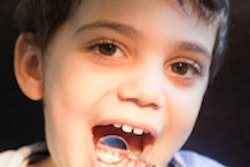
School-based oral health programs and an emphasis on creating a dental and/or medical home have a positive impact on overall dental care among Medicaid children in the U.S., according to a new study in Pediatrics (June 4, 2012).
Researchers from the U.S. Centers for Medicare and Medicaid Services (CMS) and the University of Alabama at Birmingham School of Dentistry used Medicaid research files and information from the CMS 416 Early Periodic Screening, Diagnostic, and Treatment forms (Medicaid Analytic Extract) for 2002 and 2007 to evaluate the prevalence of dental care visits among Medicaid-enrolled children ages birth to 18. They stratified the data by age, race, type of health plan, and Children's Health Insurance Program (CHIP) status.
"To our knowledge, this is the first study to evaluate the prevalence of dental care by using paid Medicaid claims," the study authors wrote. "Consistent with other reports, levels of dental care visits were low; but when the number of visits was stratified by age and type plan, striking patterns emerged, suggesting that a combination of school programs and having a medical home may have a positive impact on dental care."
They identified codes by using current dental terminology codes; any day with one or more current codes was counted as a dental care visit. If there were two or more codes on that day, they were coded separately for type of service. For example, if there was a preventive and restorative code during a visit, a child had a preventive service and a restorative service that day.
In addition, because most states send the CMS a code indicating a dental care visit for children enrolled in prepaid health plans for which there are no claims, when one of these codes occurred, it was counted as a dental care visit.
Still deficits in most states
The researchers found that, based on actual paid Medicaid claims data, access to dental services for Medicaid-eligible children has increased 16% nationally between 2002 and 2007. In addition, dental care visits among toddlers and infants were low in all but three states and in most states peaked at the age of school entry.
"In this analysis of paid dental claims, we found that most dental care is provided to children just entering school systems," they wrote.
The researchers also found that racial differences were minimal in most of the states, that CHIP participation improved access to dental services, and that children in organized health plans received more dental services.
"These results indicate that there has been some improvement in dental care for Medicaid-covered children in the past decade but that there remain deficits in most states," they wrote.
While Medicaid dental services have improved since 2002, they varied substantially by state, age, and type of insurance, according to the study findings. For example, in 2007 the prevalence of Medicaid dental visits ranged from 12% in Nevada to 49% in Vermont and didn't reach 50% in any state.
However, these results are likely an underestimate of the true prevalence of dental care for low-income children because children may receive free dental services in health centers funded by the Healthcare Resources and Services Administration (HRSA) or any number of free school and community programs, the authors noted.
Joel Berg, DDS, president of the American Academy of Pediatric Dentistry, called the study findings "very promising."
"At least there is an increase in utilization and a goal on the part of CMS to mandate more increases," he told DrBicuspid.com. "They are asking state Medicaid dental programs for a 10% increase in the delivery of preventive dental services over five years, which is easily achievable."
More attention needs to be given to one age group in particular, he added: those under the age of 3.
"Although we’ve seen some growth across all groups, an area that still needs some improvement is the 0 to 3 group," he said. "In Washington, where I live, the ABCD [Access to Baby & Child Dentistry] Medicaid program has done a pretty good job of attracting the very youngest, but it’s still not good enough. That is where the emphasis needs to be going forward. That's where our focus needs to reside."



















